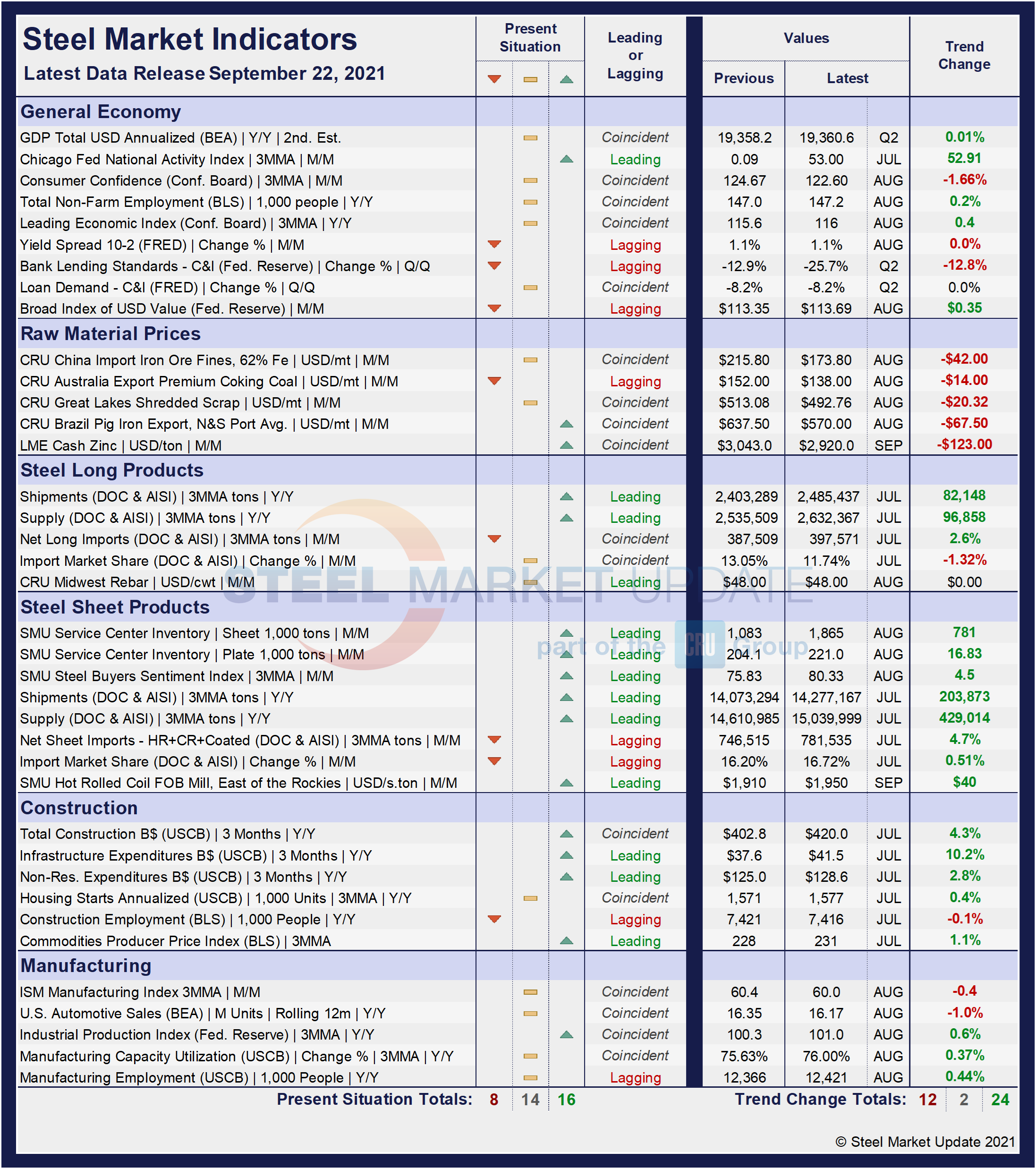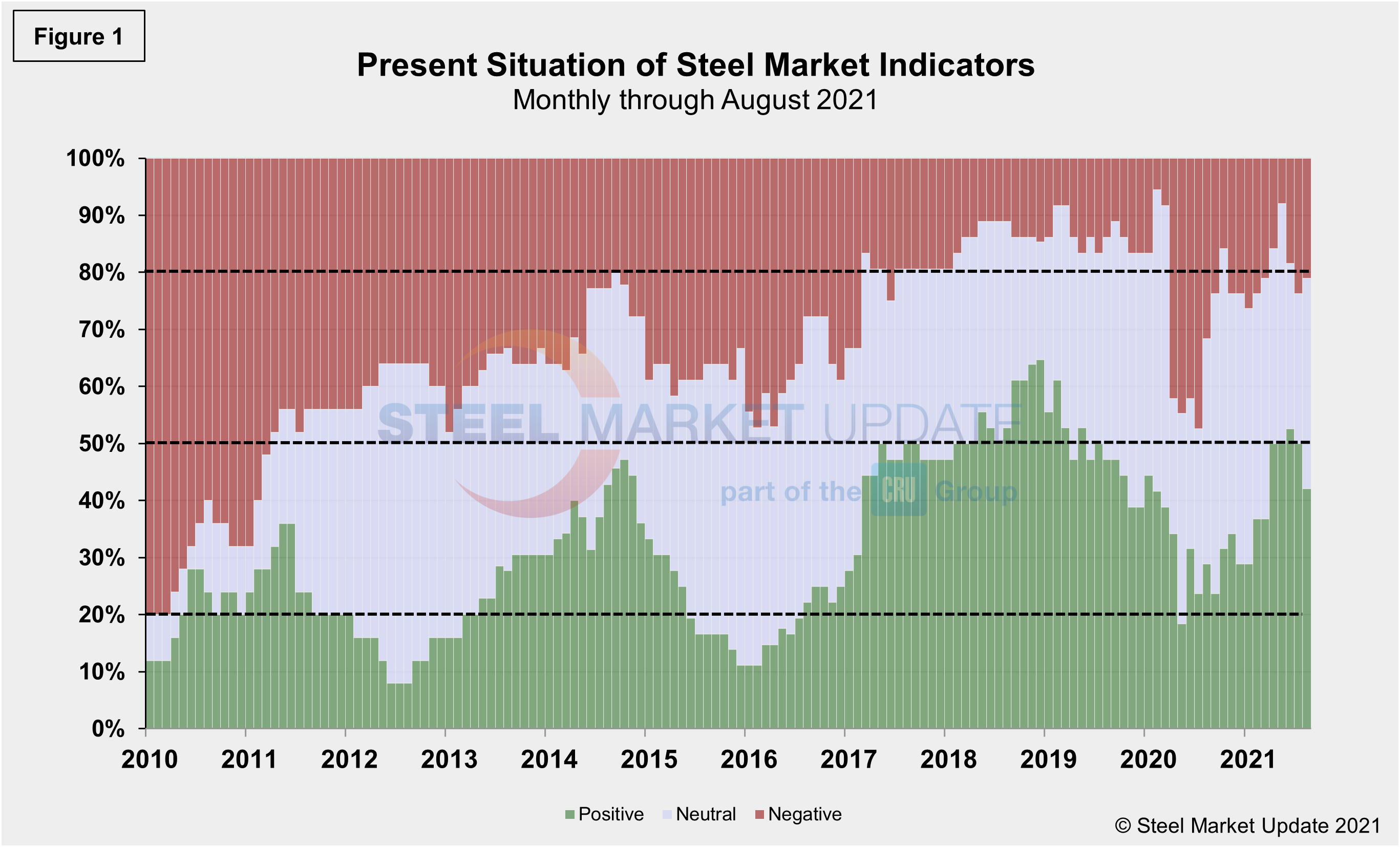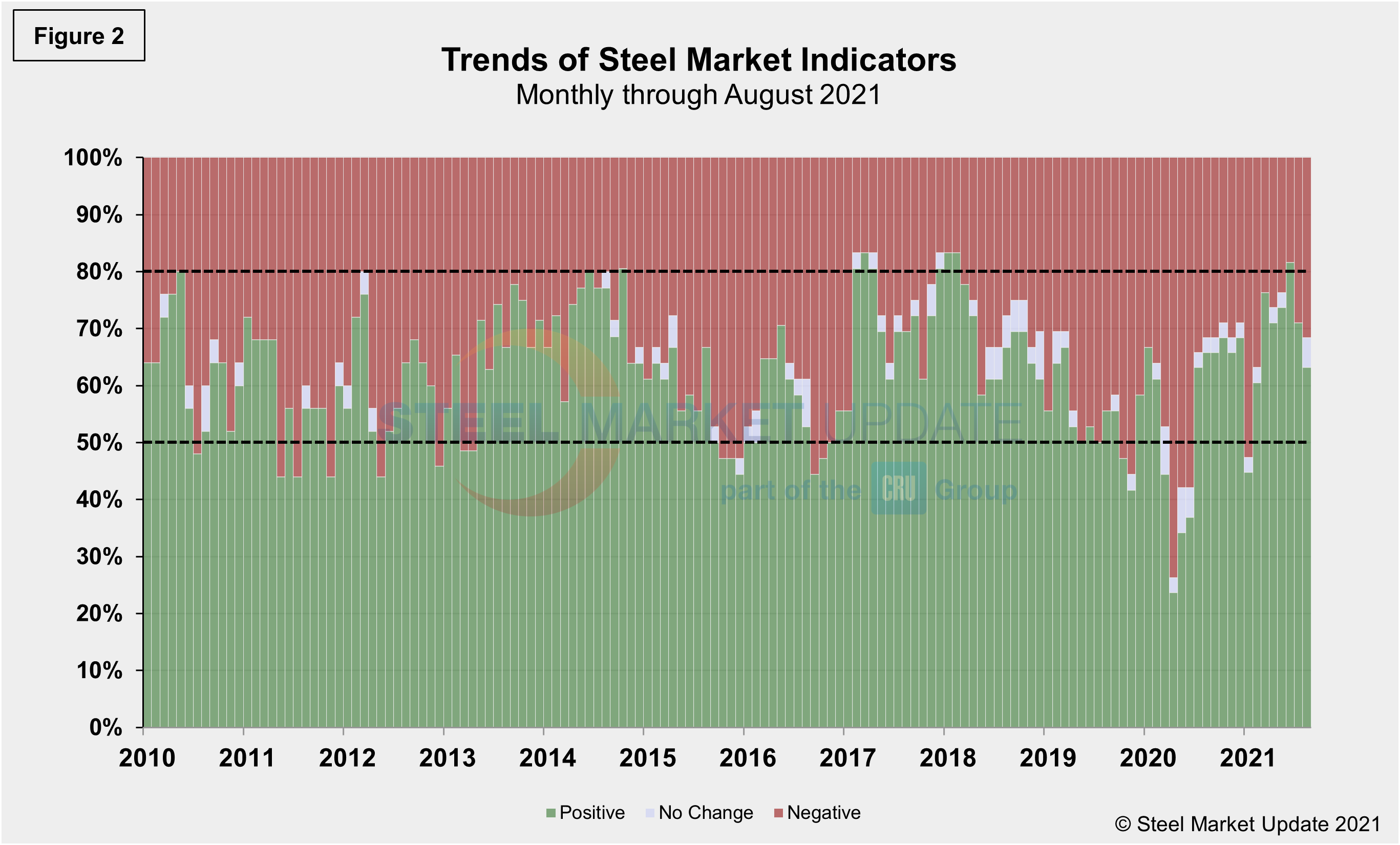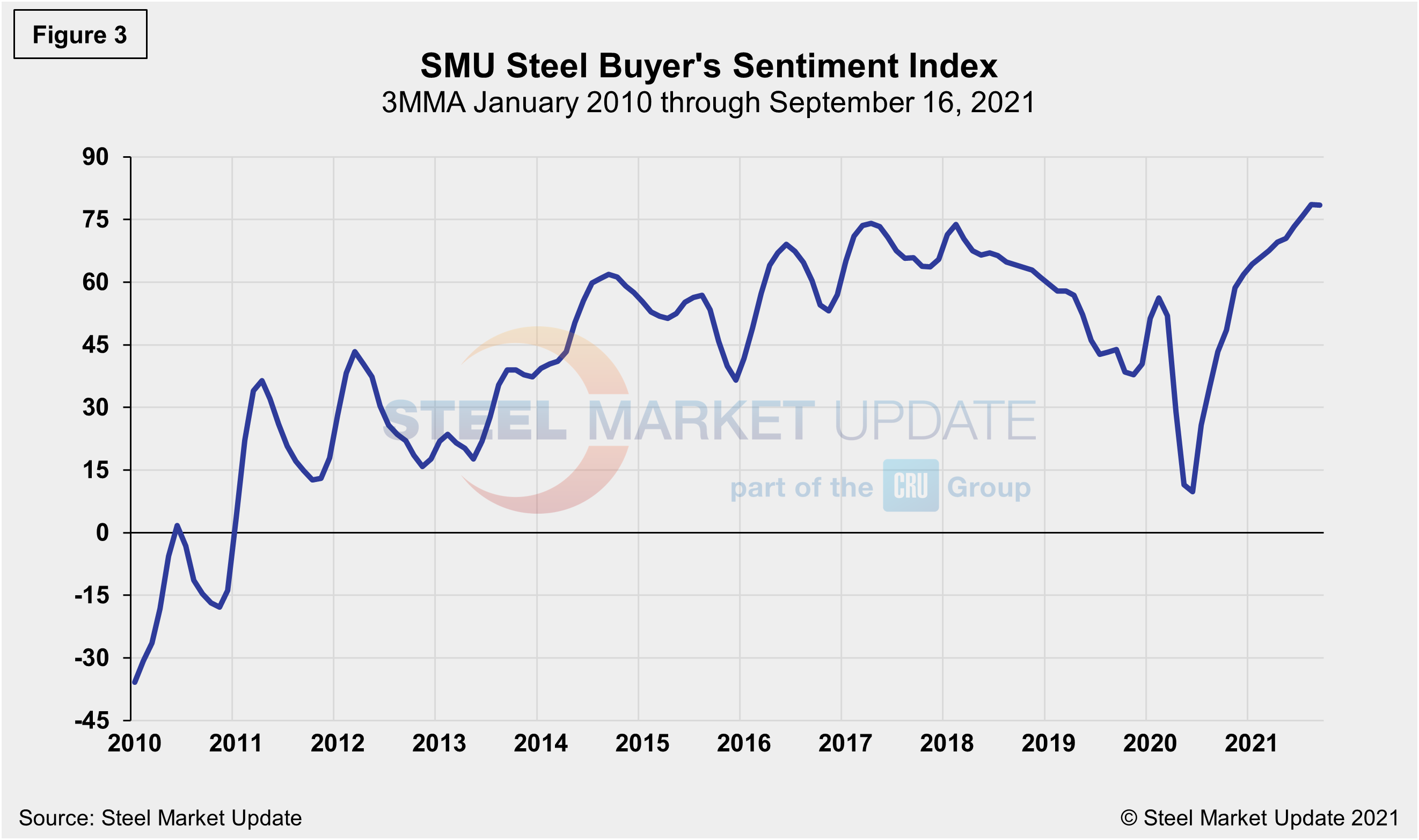SMU Data and Models

SMU Key Market Indicators: Uncertainty Gaining Ground
Written by David Schollaert
September 22, 2021
Monthly Key Market Indicators, as analysed by Steel Market Update, slipped again in the past month, albeit slightly. The typical summer slowdown may have been compounded by the ongoing drag of COVID-19 as well as an uneasy economic and political landscape.
Markers for the Present Situation have contracted for a third straight month and Trends are following, slipping for a second consecutive month. SMU’s Key Market Indicators include a host of data on the economy, raw materials, manufacturing, construction, and steel sheet and long products, offering a snapshot of current sentiment and the near-term expected trajectory of the economy.
In the latest data, eight of the 38 Present Situation indicators are negative, compared to the month prior when nine of the 38 indicators were negative. The main change when compared to July’s assessment has been a shift to neutral, which rose from a reading of 10 to 14 month on month through August. The positive indicator lost momentum, slipping from 19 to 16 over the same period.
Negative indicators trended down consecutively from February through May reaching as low as three. However, August’s indicator now stands at eight, remaining in line with last year’s slow recovery out of the initial COVID-doldrums. At its worst, 18 of the 38 indicators shifted negative last year as the economy grappled with pandemic-related disruptions. Even though current measures are far from the downturn seen more than 18 months ago, the improvements have decelerated and remain uneven. This tendency draws attention to the complexities of the economic recovery and what many may feel is the lack of a clear path forward.
SMU’s Present Situation and Trends analyses in the table below are based on the latest available data as of Sept. 22, 2021. Readers should regard the color codes in the “Present Situation” column as a visual summary of the current market condition. The “Trend” columns are also color coded to give a quick visual appreciation of the market’s direction. All data included in this table was released within the past month. The month or specific date to which the data refers is shown in the second column from the far right.Click to expand the table below.

Present Situation
SMU’s Present Situation indicators below show that the road to recovery has been long and anything but smooth. The trend was up and gaining ground until June, but has since eroded repeatedly. Positive indicators rose from 11 to 20 through June, but are now at 16, and could trend down further in the near-term. Negative indicators had grown twice over the past three months but eased in August. The more telling trend is the growth in neutral indicators, presently up four points in August, suggesting the market’s direction is unclear.
Supply shortages in the auto and construction sectors, growing producer prices, an underperforming employment sector, rising cases of the Delta variant, and other factors are likely playing a role in the marketplace’s hesitation and potential lack of direction. The Labor Department said that producer inflation accelerated in August as wholesale prices rose 8.3% from a year ago, while the consumer price index increased 0.7% in August, in line with July’s figure and matching the highest 12-month rate since August 2008.
Present results show a shift to uncertain compared to last month’s data due to the rise in the neutral totals. Presently, nearly 37.0% of the marketplace is neutral or unclear, a 10-percentage point increase from July and a nearly 12.0% jump from July’s totals. Even though the positive markers dipped eight percentage points to 42.1% in August, 78.9% of the population still sees the marketplace as encouraging, or neutral to positive.
Our most recent assessment indicates that 21.1% see the market’s present situation as negative, a slight improvement from the 23.7% the month prior. Our monthly assessment of the Present Situation since January 2010 on a percentage basis is shown in Figure 1.

Trends
SMU’s Trends indicators saw movement similar to the Present Situation, however, most values in the Trends columns are three-month moving averages (3MMA) to smooth erratic monthly data. Nevertheless, there was a repeated shift negative in the latest data. Note that in many cases this is not August or September data, but data that was released in August and/or September for previous months. Compared to month-ago data, the negative trend rose to 31.6%, compared to 28.9% and up more than 13 percentage points from June. The neutral trend grew 5.3%, after being at zero for the two prior months. The positive trend lost ground from 71.1% to 63.2%, and down nearly 19 percentage points in two months. These results may be a result a summer slowdown, but are more characteristic of a marketplace lacking direction and a slowdown in the economic rate of growth. Figure 2 shows the recent movement of the trends and historical movement for comparison.

The SMU Steel Buyers Sentiment Index is a measure of the current attitude of North American steel buyers regarding their company’s chances for success in today’s market. The single value of the current sentiment index fell from +58 in early March 2020 to -8 less than a month later. It has since rebounded to a healthy +78 as of Sept. 16. Figure 3 shows the 3MMA of the index since 2010. A reading above the neutral point of zero indicates that buyers have a positive attitude about their prospects. Rising demand and historically high steel prices should keep the Steel Buyer’s Sentiment Index at a highly optimistic level for the foreseeable future.

By David Schollaert, David@SteelMarketUpdate.com

David Schollaert
Read more from David SchollaertLatest in SMU Data and Models

SMU’s June at a glance
A look at SMU data for the month of June.

SMU Survey: Buyers’ Sentiment rebounds from multi-year low
Both of SMU’s Steel Buyers’ Sentiment Indices edged higher this week. Current Sentiment rebounded from a near five-year low, while Future Sentiment rose to a two-month high

SMU flat-rolled market survey results now available
SMU’s latest steel buyers market survey results are now available on our website to all premium members.

SMU Survey: Sheet lead times pull back after early-June blip, plate holds
Following the uptick seen two weeks ago, lead times eased this week for all four sheet products tracked by SMU, while plate lead times held steady, according to this week’s market survey.

SMU Survey: Pricing power abruptly shifts to steel buyers
The majority of steel buyers responding to our latest market survey say domestic mills are more willing to talk price on sheet and plate products than they were earlier this month. Sheet negotiation rates rebounded across the board compared to early June, while our plate negotiation rate hit a full 100%.
